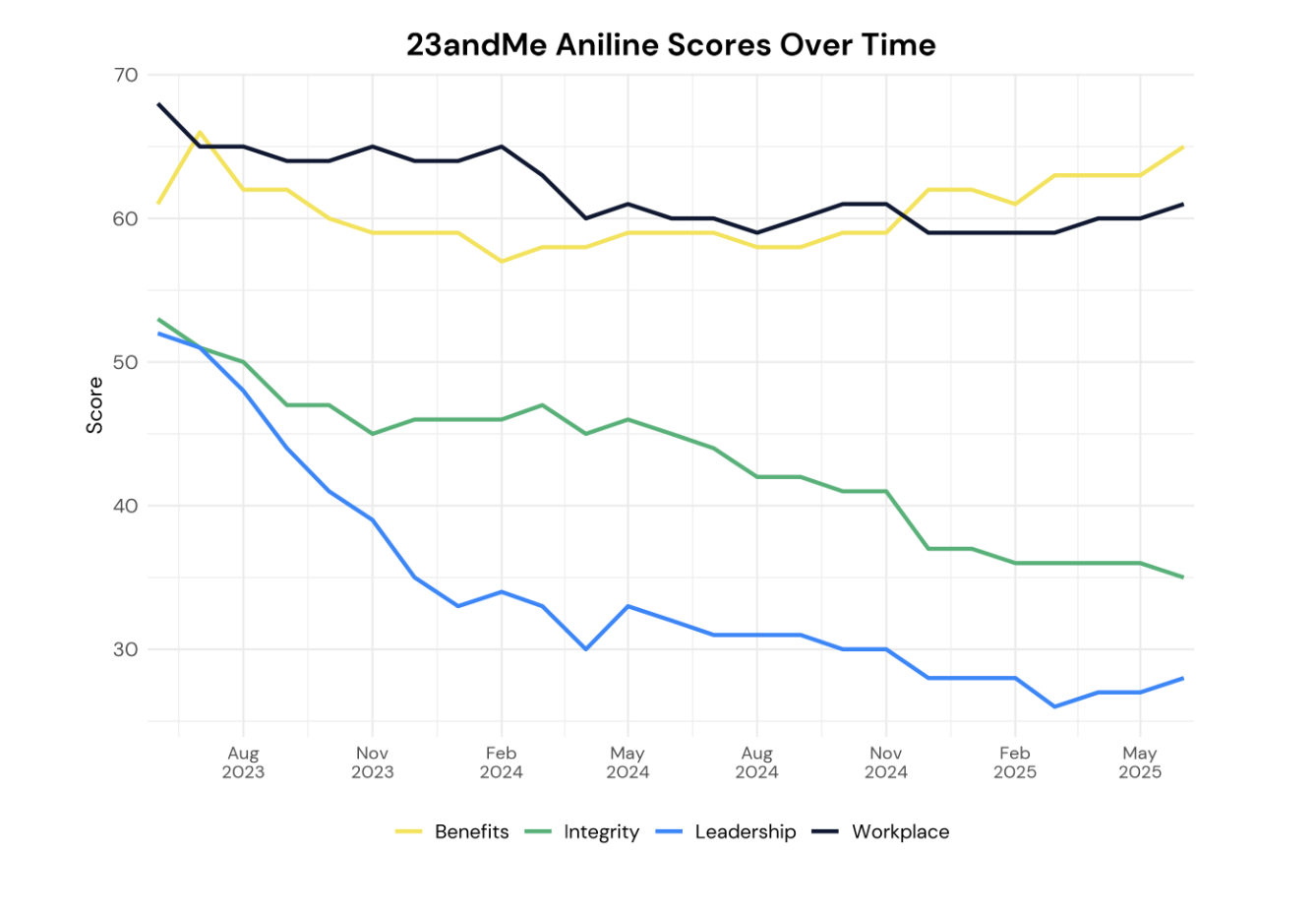23andMe's Downfall Was Inevitable: How Dysfunctional Leadership and Employee Revolt Predicted the Company's Collapse
23andMe has dominated headlines recently, but not for the reasons the genetic testing company would prefer. According to Aniline's employee sentiment data, the warning signs were flashing red long before these troubles became public knowledge.
From data breaches to plummeting stock prices and leadership upheaval, the once-promising biotech darling has faced a cascade of challenges that have left investors and customers questioning its future. But for those paying attention to employee sentiment data, these issues shouldn't come as a surprise.
A Leadership Crisis Hiding in Plain Sight
The most damning findings center on 23andMe's leadership effectiveness. With an Aniline score of just 28 in Leadership (ranking in the 9th percentile), employee feedback painted a picture of an organization in distress:
"The leadership team as a whole is dysfunctional,"
one employee reported, while another stated bluntly, "The CEO is terrible."
Perhaps most telling was this observation: "A decision is made at an exec meeting only to be reversed by an exec talking directly to the CEO." This pattern of erratic decision-making and poor accountability created what employees described as "whiplash on just about every decision."
These aren't just internal HR concerns, they're indicators of fundamental governance problems that can derail any organization, regardless of how innovative its technology might be.
The Integrity Gap
With an integrity score of 35 (10th percentile), 23andMe's internal culture showed serious cracks. Employees consistently reported "absolutely 0 accountability or acknowledgement of bad decisions" and described a leadership approach focused more on "leadership's job security" than on the company's mission.
When leadership prioritizes self-preservation over strategic execution, it creates a cascade of problems:
- Poor risk assessment and management
- Inadequate response to emerging threats
- Loss of employee trust and engagement
- Compromised decision-making during critical moments
Cultural Strengths Undermined by Leadership Failures
Ironically, 23andMe showed significant strengths in areas that should have been competitive advantages. The company scored well in workplace culture (61, 89th percentile) and benefits (65, 69th percentile), with employees consistently praising:
- "Great people, wonderful ICs and managers"
- Strong mission alignment: "People really cared about the mission and poured their hearts into their work"
- Innovative technology and supportive work environment: "The technology is incredible and the people are really sharp"
However, these cultural assets were systematically undermined by leadership dysfunction. As one employee noted: "Love the mission, but we lack a path to get there."

The Integrity-DEI Disconnect: When Actions Don't Match Words
A particularly revealing finding was the gap between 23andMe's stated diversity, equity, and inclusion commitments and employee experiences. While the company promoted "DEI as a core value," employees reported "significant gaps between the stated commitment and everyday experiences," including instances of "microaggressions if you're not white or male."
This disconnect represents more than just a diversity challenge, it's fundamentally an integrity issue that signals broader organizational problems. When companies fail to deliver on stated values, it often indicates systemic issues with accountability and follow-through that extend beyond any single policy area.
Companies that struggle to implement their stated commitments effectively may also experience challenges with:
- Consistent policy implementation across other business areas
- Accurate self-assessment and risk identification
- Stakeholder trust and reputation management
- Regulatory compliance and ethical standards
The Communication Breakdown
The data revealed a critical communication crisis that should have been a red flag for any crisis management team. Employees consistently reported:
- "Lack of transparency and communication"
- "No process for decision-making"
- "No idea where future of company is headed"
When a company faces external challenges, whether regulatory scrutiny, competitive pressure, or security breaches, effective internal communication becomes crucial. 23andMe's communication failures likely hampered its ability to respond effectively to emerging crises.
What This Means for Stakeholders
The Aniline data suggests that 23andMe's recent troubles weren't sudden external shocks but rather the predictable result of longstanding internal dysfunction. For various stakeholders, this offers important lessons:
For Investors
Employee sentiment data can provide early warning signals about governance risks that may not be apparent in financial statements.
For Customers
Understanding a company's internal culture can offer insights into its ability to protect sensitive data and maintain service quality.
For Employees
Culture and leadership effectiveness directly impact career development, job security, and workplace satisfaction.
For Regulators
Companies with poor internal governance may pose higher risks for compliance failures and consumer protection issues.
The Broader Lesson
23andMe's situation illustrates a crucial point: employee sentiment isn't just an HR metric, it's a leading indicator of organizational health and future performance.
Companies that ignore internal warning signs do so at their own peril. In today's interconnected business environment, internal dysfunction rarely stays internal for long. Poor leadership, communication breakdowns, and cultural misalignment create vulnerabilities that external pressures will inevitably exploit.
The question for 23andMe, and for other companies facing similar challenges, is whether they'll address these fundamental issues or continue to treat the symptoms while ignoring the underlying disease.
For stakeholders across the ecosystem, the lesson is clear: pay attention to employee sentiment data. It often tells the story of a company's future long before that story appears in the headlines.
Access the Complete Analysis
Learn how employee sentiment data can serve as your early warning system for organizational crises. See the full picture before it becomes front-page news.